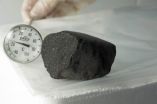(Press-News.org) New research shows how the protein missing in fragile X syndrome – the most common inherited form of intellectual disability – acts as a molecular toggle switch in brain cells.
The fragile X protein, called FMRP, hooks up with a group of molecules called microRNAs to switch the production of other proteins on and off in response to chemical signals, scientists at Emory University School of Medicine have discovered.
The results appear in the June 10 issue of Molecular Cell.
"For learning and memory to take place, neurons need to be able to make new proteins on demand, at particular synapses in a localized way," says senior author Gary Bassell PhD, professor of cell biology and neurology at Emory University School of Medicine. "It appears that FMRP has evolved to use microRNAs to control the synthesis of proteins at synapses."
The research team included the first author, Ravi Muddashetty PhD, and contributing co-authors, Vijayalaxmi Nalavadi PhD, Christina Gross PhD, Xiaodi Yao, Oscar Laur PhD and Lei Xing PhD. This research was done in collaboration with Stephen Warren PhD, professor and chair of the Department of Human Genetics.
In fragile X syndrome, FMRP's absence leads to overactive signaling and unregulated protein production at synapses, the junctions between brain cells where chemical communication occurs. This leads to structural changes at synapses and an impairment of cells' ability to respond to chemical signals, which in turn interferes with learning and memory.
Muddashetty and Bassell focused on a particular protein called PSD-95, whose production they had previously discovered was regulated by FMRP – although they didn't know how FMRP exerted its control. PSD-95 appears to have an important role in anchoring together signaling molecules at synapses, the parts of neurons directly involved in learning and memory. Mice lacking the gene for PSD-95 develop normally but have more difficulty learning the location of a hidden platform in a water maze, compared with normal mice.
"The changes at synapses seen in fragile X syndrome are probably not caused by the overproduction of a single protein," Bassell says. "But we think that losing the ability to make PSD-95 on demand is an important component."
In cultured neurons, Muddashetty studied part of the RNA molecule encoding PSD-95, which responds to excitement by the neurotransmitter glutamate. This way he could dissect which proteins and RNA molecules were needed. Interfering with a particular microRNA, called miR-125, could stop the PSD-95 RNA from responding to glutamate signaling and could even drive neurons to produce more protrusions at their synapses.
MicroRNAs are involved in a process called RNA interference, whose discovery earned the 2006 Nobel Prize in Medicine. RNA interference is a way that short RNA molecules (microRNAs) can silence a stretch of genetic code.
These tiny RNA molecules have become a widely used laboratory tool for shutting off a specific gene. When the RNA molecules are introduced into the cell, they are actually hijacking a machine inside the cell called RISC (RNA-induced silencing complex). MicroRNAs normally govern the activity of RISC, which can prevent a given gene from being translated from RNA into protein.
In a sense, FMRP is acting as a "RISC manager." Together with microRNA, it clamps down on an RNA, preventing the synthesis of protein, until glutamate signals force them to loosen up. Thus, FMRP determines when the protein should be made at the synapses.
"Future work may uncover whether this is a general mechanism to guide specific miRNAs onto target mRNAs at synapses," the authors write.
The finding illustrates how microRNAs are emerging as key players in neurological development and disease, Bassell says. Since a given microRNA can regulate hundreds of targets, one potential drug strategy for fragile X syndrome would be to aim at restoring microRNA function.
###
The research was supported by the National Institutes of Health, the Fraxa Research Foundation and National Fragile X Foundation.
Reference:
R.S. Muddashetty, V.C. Nalavadi, C. Gross, Xiaodi Yao, L. Xing, O. Laur, S.T. Warren; and G. Bassell. Reversible inhibition of PSD-95 mRNA translation by miR-125a, FMRP phosphorylation and mGluR signaling. Mol. Cell (2011).
The Robert W. Woodruff Health Sciences Center of Emory University is an academic health science and service center focused on missions of teaching, research, health care and public service.
Learn more about Emory's health sciences:
Blog: http://emoryhealthblog.com
Twitter: @emoryhealthsci
Web: http://emoryhealthsciences.org
END
GOES-13 satellite imagery on June 9 shows that the pesky low pressure area in the north Caribbean Sea is stretching out and bringing soaking rains to Cuba, Hispaniola, Jamaica and Puerto Rico.
The Geostationary Operational Environmental Satellite called GOES-13 captured an image of this low on June 9 at 1740 UTC (1:40 p.m. EDT) System 94L, and the cloud cover appears centered over eastern Cuba and Jamaica while the outer portion of the low stretches over Hispaniola, Puerto Rico and now south Florida. The elongated low has a minimum central pressure of 1001 millibars and ...
In April 2007, teacher Irka Elsevier and then-graduate student Biance Moebius-Clune began their second inquiry unit designed to enable high school students to better understand soil science concepts through their own research and experiments. Moebius-Clune was an NSF fellow in the Cornell Science Inquiry Partnerships (CSIP) program, which allowed the pair to develop inquiry curriculum to guide students through the process of doing research themselves.
Soil is fundamental to life and relevant to some of today's most pressing global issues, such as climate change and demand ...
NASA's Aqua satellite and the GOES-13 satellite both captured their own unique views of the eruption of the Puyehue-Cordón Caulle volcano in Chile this week. One satellite provided a high-resolution image of the ash plume while the other provided a video showing the plumes movement over several days.
NASA's GOES Project released a satellite animation of the Puyehue-Cordón Caulle volcano that shows the movement of the ash plume over several days. The NASA GOES Project, located at NASA's Goddard Space Flight Center, Greenbelt, Md. created the animation from images obtained ...
Some asteroids may have been like "molecular factories" cranking out life's ingredients and shipping them to Earth via meteorite impacts, according to scientists who've made discoveries of molecules essential for life in material from certain kinds of asteroids and comets. Now it appears that at least one may have been less like a rigid assembly line and more like a flexible diner that doesn't mind making changes to the menu.
In January, 2000, a large meteoroid exploded in the atmosphere over northern British Columbia, Canada, and rained fragments across the frozen surface ...
AMARILLO – A two-year study by a Texas AgriLife Research team in Amarillo has helped bring a new product to market that could allow the cattle feeding industry to realize efficiencies in mills and more weight on cattle, according to Dr. Jim MacDonald.
MacDonald, an AgriLife Research beef cattle nutritionist, finished his second trial of cattle early this year studying starter diets in feedlots during the transition phase from pasture to feed yard.
Typically, a steer or heifer will come off of a forage diet when it goes into the feedlot, he explained. For the first ...
NASA's Dawn mission to the doughnut-shaped asteroid belt between Mars and Jupiter, which launched in September 2007, is now approaching Vesta, a protoplanet that is currently some 143 million miles from Earth. Many surprises are likely awaiting the spacecraft.
"We often refer to Vesta as the smallest terrestrial planet," said Christopher T. Russell, a UCLA professor of geophysics and space physics and the mission's principal investigator. "It has planetary features and basically the same structure as Mercury, Venus, Earth and Mars. But because it is so small, it does ...
(Santa Barbara, Calif.) -- In recent years, UC Santa Barbara scientists showed that they could reproduce a basic superconductor using Einstein's general theory of relativity. Now, using the same theory, they have demonstrated that the Josephson junction could be reproduced. The results are explained in a recent issue of the journal Physical Review Letters.
The Josephson junction, a device that was first discovered by Brian David Josephson in the early 1960's, is a main ingredient in applications of superconductivity.
Gary Horowitz, professor of physics at UCSB, said ...
VELUX America is introducing a low profile, flat glass design Sun Tunnel skylight at the International Builders' Show in Orlando.
The new model tubular skylight will captures more light while offering an enhanced roof profile and is ideal for use where acrylic dome Sun Tunnel skylights cannot be used. The new units will be available initially only in a 14" diameter model with rigid tubing.
Stephan Moyon, Director of Sales, says that Sun Tunnel skylights are perfect for any room where a view to the outside is not needed or where traditional skylights may not be ...
[EMBARGOED FOR JUNE 10, 2011] Although liver-related mortality among those infected with hepatitis C is well-documented, little is known about deaths in these patients that are not related to liver problems. A new study published in Clinical Infectious Diseases and now available online (http://www.oxfordjournals.org/our_journals/cid/cir306.pdf) sought to determine mortality from all causes, including liver- and non-liver related deaths among hepatitis C patients in the general U.S. population. The analysis found mortality from all causes to be higher in these patients.
An ...
Didriks - www.didriks.com - announces colorful new Revolution ceramic cookware designs for 2011 from Revol porcelain.
Created in France from a revolutionary proprietary ceramic material, the new Revolution cookware has a higher thermal shock resistance than any other non-porous culinary ceramic known today. Thus, the pots can be used on any kind of stove top, in microwave ovens and are dishwasher friendly.
Jonathan Henke of Didriks said, "This new collection from Revol is such a great addition to all of our cookware lines. Revolution fills our customers' need ...




